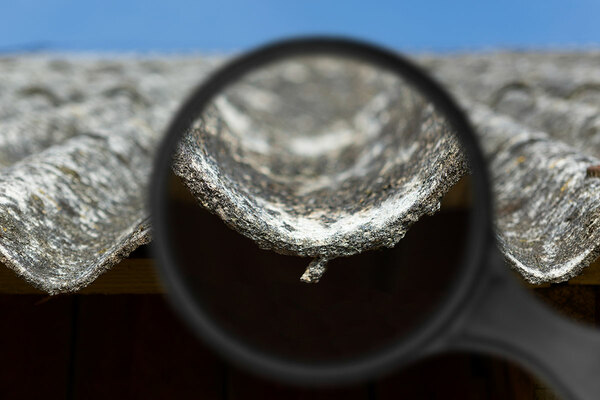The lingering asbestos threat in our social homes
Katharine Quarmby details the scale of the hidden asbestos challenge in social housing. Illustration by Michelle Thompson
“It could be in everything, everywhere,” says Jonathan Grant about asbestos in social housing. As a committee member of the National Organisation of Asbestos Consultants (NORAC), he is in a good position to know.
In conjunction with the Asbestos Testing and Consultancy Association (ATaC), NORAC launched the first-ever review of UK asbestos management in a report to parliament last November. Of 128,761 buildings experts examined over a six-month period, 78% had asbestos.
Asbestos is most dangerous when it is damaged, as fibres of the lethal mineral can come loose and become airborne. This is how most people are thought to develop asbestos-related diseases. And 71% of the asbestos items recorded in this report were damaged.
“There is currently a high proportion of asbestos materials in UK buildings that could present a potential risk to public health,” the report concludes.
Although it was banned in the UK in 2000, asbestos can still be found in a high percentage of buildings where people study, live and visit. Social housing, much of which was built when asbestos was still widely used in construction, is one of the sectors most affected. The data exposes the scale of the problem: 73% of buildings analysed in the report belonged to social landlords.
Unlike fire risk or mould, the dangers of asbestos are largely hidden. Mr Grant explains: “It might be in floor tiles, textured coatings, panels behind flues, in insulating boards. It’s important to be balanced about the risk, but it really is in everything.”
This means that the deadly substance isn’t necessarily visible, although, as the report stresses, “the number of annual asbestos deaths is the equivalent of a Grenfell Tower fire happening every five days”.
Hard to assess
It is also hard to assess the risk from asbestos simply being present, as it can require lab testing to measure how damaged it is. Trained professionals must assess the damage and the risk arising from it, using a long checklist from workplace safety regulator the Health and Safety Executive (HSE).
The long latency period between exposure and diagnosis also means that it can be difficult to show cause and effect.
This is backed up by Isobel Lovett, who heads up the asbestos team at legal firm Hodge, Jones and Allen. “Claims for compensation for the asbestos-related cancer, malignant mesothelioma, arising from exposure in buildings, whether housing, schools or hospitals, can be challenging to prove. Identifying the source of the exposure – often decades earlier – can be difficult,” she tells Inside Housing.
John Richards, a committee member for ATaC who co-wrote the asbestos report with Mr Grant, points out that the risk from asbestos has changed over time. Early cases came about after people were exposed in heavy industry. “People are now exposed to a low level of the fibre over a long period of time, but there is no research being done on that risk,” Mr Richards says.
“This is a real challenge. We are now aware of the tragic circumstances of Awaab Ishak, the young lad who died of mould exposure. When we see news of such incidents, many of the ceilings affected have textured coatings which probably contain asbestos. It may be low risk, but this is a real challenge.”
This was borne out by the tragic death from mesothelioma in 2011 of social housing tenant John Shiers, who lived in a housing block in Hulme which Inside Housing reported was “riddled with asbestos”. It was one of the first deaths in social housing for which the landlord admitted limited liability.
Insufficient regulation
The Control of Asbestos Regulations 2012, enforced by the HSE in conjunction with councils, covers asbestos in common areas of social housing, such as hallways. If a duty holder is going to do any renovation in a block, they are also expected to look for and remove asbestos.
But the scope of the work is then restricted to the areas they are renovating, rather than checking the whole dwelling. The failure of the regulations to cover all areas in social housing was criticised by organisations that gave evidence to the Work and Pensions Select Committee, when it reported on how the HSE carries out asbestos management last year. Unite, the union, told MPs that it had “a particular concern around social housing” because of “the very poor state of this housing stock”.
Some contractors are complacent or ignorant about the risk, and fail to share knowledge with tenants when asbestos is removed, says Ms Lovett. Her firm is seeing an increasing number of cases of younger people who may have been exposed to asbestos in rented accommodation.
Mr Grant says many of his clients are in the social housing sector, where there is variation in compliance around asbestos management. “Many are managing it well, and some are proactive; [they] will survey all their stock and keep their asbestos register up to date,” but others do “the bare minimum”, he says.
Confusion around how to handle asbestos safely is demonstrated by an ongoing strike by members of Unite working for Magenta Living, a housing association in the Wirral. They are pushing back against a new policy that, they say, expects them to work with asbestos.
Inside Housing submitted Freedom of Information requests to the Housing Ombudsman as part of an investigation into the harms of asbestos in buildings. Tenants have been able to complain to the ombudsman about failures or delays in acting on reports of asbestos since 2013. But the ombudsman only started to track these complaints separately in 2018.
It told us it received 246 complaints between January 2018 and December 2021, and has made a decision on 33 of these: 20 found no maladministration, while the others found service failure, maladministration or asked for redress.
The select committee recommended that the government set a 40-year deadline for removing asbestos, starting with non-domestic buildings such as schools.
The government refused, arguing that its current latency strategy, where asbestos is not removed unless damaged, was safer than removal, during which fibres could be released and become airborne.
This frustrates Mr Grant. “There is no deadline for the UK to be asbestos-free and, at our current rates of removal, it is never going to happen,” he says.
“There is no deadline for the UK to be asbestos-free and, at our current rates of removal, it is never going to happen”
We asked the Department for Work and Pensions for comment, and this was passed to the HSE. The executive told us: “The best available evidence shows that if asbestos is present, if it is undisturbed, sealed and closely monitored, it can be safely managed in situ.
“Asbestos is only dangerous if not maintained in a safe condition or if physically disturbed without the right measures in place to control exposure. Where it cannot be safely managed in situ or is damaged, it should be removed by a competent person. Where present, asbestos should be closely monitored by those responsible for the building.”
But as most tenants are not aware of where or if asbestos is present in their property, they might easily disturb it through something as simple as hanging a picture. Additionally, when asbestos falls into disrepair, it is at its most dangerous.
With reference to the report on damaged asbestos, the HSE added: “We have not yet seen how the data from this report was collected, so cannot judge its accuracy – although we welcome any expansion of the evidence base and will consider the findings once we can verify their accuracy.”
The housing sector can still act unilaterally. Mr Richards suggests that social landlords should at least resist the pressure to move a new tenant into an empty property if asbestos is present. “The thing that is missing at the moment is taking the opportunity to remove high-risk asbestos where it exists,” he says.
This story was reported with funding from Journalismfund.eu, as part of Katharine Quarmby’s involvement in a cross-border investigation called Asbestos: The Lethal Legacy. The project is led by Investigative Reporting Denmark, edited by Ms Quarmby, in collaboration with journalists from Knack in Belgium, Tygodnik Powszechny and Reporters’ Foundation in Poland, Ostro in Croatia and Slovenia, IRPI in Italy, De Groene Amsterdammer in the Netherlands, Grupo Merca2 in Spain, Al Jazeera in the UK and TV2 Nord in Denmark.
Sign up for our regulation and legal newsletter
Already have an account? Click here to manage your newsletters












